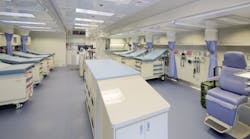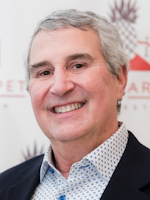I started my mobile dental practice, Dental Access Carolina LLC (DAC), in 2001 as an outreach project of my traditional practice. It was an experiment because I wasn’t sure how bringing comprehensive dental services to economically disadvantaged children at their schools would be received. I questioned whether the model could pay for itself from the fees generated versus the funds from donations and grants. Therefore, the cost entering an unknown market was a major factor.
To conserve funds, I acquired a used RV, removed the furniture, installed used dental equipment, and began my journey into the world of mobile dentistry. After just six months, it was apparent the model was working. The need and demand were greater than I could fulfill just one day per week, so I sold my traditional practice to focus on mobile dentistry full time.
I realized that while my retrofitted RV was functional, it was not ideal. This prompted me to search for a manufacturer that would build a mobile clinic to my specifications. It needed all the components that would allow me to practice as closely to the way I did in my brick-and-mortar facility, while also being maneuverable and affordable.
My exhaustive search of companies who manufacture RVs and advertise mobile clinics did not lead me to a clinic that met all my needs. Not to be deterred, I designed my own clinic and found a company who specializes in custom specialty vehicles. They saw my vision and agreed to manufacture my first mobile dental clinic in 2002. We secured an exclusive agreement with that company, and Dental Access Mobile Clinics LLC was started in 2003.
More by Dr. John Reese
Mobile dentistry: The road less traveled
Mobile dentistry: Driven to excellence
Like practicing in mobile clinics, building mobile clinics is not without obstacles. One of these is people’s preconceived perceptions. When someone hears “mobile dental clinic,” what they envision varies. Based on comments I’ve heard at dental meetings, the phrase often invokes a mental image of a dirty old RV filled with random dental equipment. While it’s true that many converted RVs are being used as mobile clinics, this negative image paints mobile dentistry with a broad black brush of being substandard, cheap, or low class.
Yes, a converted RV can be a low-cost entry into the mobile clinic world. In my opinion, it’s not the best long-term solution for many reasons. The main disadvantage of using an RV is the platform on which it is built. Most RVs are designed to be used on an occasional basis, a couple times per month or less. Many are built using plywood, fiberglass, and particle board, making their durability limited when put through the paces of daily use. As a result, they tend to look very bad very fast, which lends to the substandard image many people have of mobile clinics. RVs can be an economical solution that make the difference between delivering access to care for those in need versus leaving needs unaddressed. So, we cannot completely rule out converted RVs, but there are better solutions.
The ideal model
A properly built mobile clinic should be on a commercial chassis using a steel or aluminum framework that can support the weight of dental equipment and withstand the demands of daily use. A variety of platforms can be used, including trailers, class A bus-style chassis, or class C truck cab-style chassis. Sizes vary from units that accommodate one treatment room all the way up to those built on 18-wheeler trailers that can house an entire hospital.
Mobile clinics can be designed to provide a wide variety of services, such as primary medical care, ophthalmic surgery, blood donations, medical and dental lab services, vaccinations, ultrasounds, MRIs, preventive dental services, complex restorative procedures, and orthodontics. Treatment rooms can be completely separated or be open bay designs. Restrooms, sterilization rooms, labs, administrative areas, waiting areas, and handicapped access can be included depending on the needs of the provider and patients.
Treatment does not need to be limited to one discipline. We have designed combination medical/dental clinics that have the capacity for expanded services under the awning, with umbilicals for air and suction as needed. The design options for mobile clinics are almost endless depending on the size of the platform and the user’s budget.
DAC provides ongoing comprehensive preventive and restorative treatment to people at schools, behavioral health clinics, corporations, and elder care facilities. We’ve found that a design built on a class C chassis works best for us. This chassis provides a driving experience that is most like an SUV or truck, and its size allows us to operate without a commercial driver’s license, both pluses when the drivers are nonprofessionals. Those who want an open bay design often prefer a class A unit. Of course, trailers provide the most options when going for a large clinic. Our temporary dental offices are built on trailers and designed to be connected. This creates clinics as large as the available real estate will allow.
All our mobile clinics are designed for maximum efficiency and use of space. Our standard model includes two separate treatment rooms that each accommodate four-handed dentistry. We have a restroom, panorex alcove, sterilization room, and underfloor wheelchair lift that allows handicapped access while not intruding on the interior space. Automatic levelers and adequate heating and air conditioning are also essential to allow staff to operate at maximum comfort.
While shore electrical power is an option, it’s rare for most locations to offer adequate connections, so the unit must be equipped with sufficient generator capacity to power the equipment and other electrical components. Minimal shore power to operate heating or cooling systems is essential to prevent damage to equipment when the unit is not in use in areas where temperatures are below freezing or extremely hot, especially if panoramic or cone beam x-rays are being used. The ability to operate lighting with low voltage systems and without the use of shore power or generators is a feature we include.
What works for us
We believe that clinical functions are the highest priority and best use of precious space. We’ve found that administrative and waiting areas are not vital features. We’ve proven that most administrative functions can be performed either on site or back at the office after all clinical treatment is completed, so we don’t include dedicated space for this.
Since we treat patients where they work, play, learn, or live, they can continue their normal activities until we’re ready to see them, making a waiting area unnecessary, save for a small “on deck” seat or bench. We know that others may have different needs, so we include waiting and administrative spaces for those who want them on any custom-built designs.
As for high tech or luxury features, the sky is the limit. The mobile hospital in the two photos here has a state-of-the-art surgical suite, satellite communication capabilities, and other features that afford it the ability to offer open heart surgery as soon as one hour after the unit is parked. As the first eight-hour day continues to unfold, it becomes a fully functional climate-controlled 200-bed hospital.
Our combination medical-dental clinic is equipped so that routine dental or medical procedures can be performed in a controlled area that offers a sterile environment and patient privacy. This is a far cry from the typical outreach project where treatment is performed in makeshift clinics under less-than-ideal conditions. Makeshift not only limits the types of procedures that can be performed, but also compromises the outcome.
More than 20 years of practicing in the clinics we build gives us an inside view of all phases of mobile clinic use and design. We’re convinced that as we move deeper into the second decade of the 21st century, the time is now to seriously consider mobile clinics as a viable option for providing care to patients who need access, or who want the convenience of a mobile delivery model.
Mobile clinics will never replace traditional practice modalities. But with today's advances, we can see they are no longer second-class options. The next time someone mentions a mobile clinic, hopefully you will picture some of their features and envision a functional and attractive clinic.
Editor's note: This article appeared in the November 2022 print edition of Dental Economics magazine. Dentists in North America are eligible for a complimentary print subscription. Sign up here.







